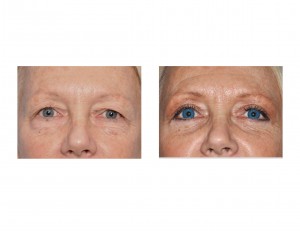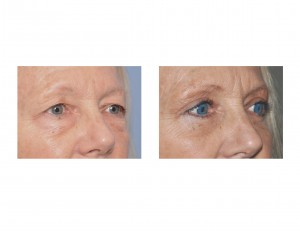Background: The constant movement of the eyelids and their thin skin makes for early and inevitable signs of aging. The eyelids almost always shows the signs of age first. It is also easily observed since the eyes are the fundamental focal point of human conversation. The signs of periorbital aging are always associated with such patient complaints as ‘I look tired’, ‘I look older than I feel’ and ‘My eyes feel heavy’.
Despite the relatively small amount of upper eyelid skin that naturally exists, it is incredible how much excessive and loose skin can be created. Often it appears that there is at least twice as much skin present than would normally exist in the upper eyelid as one ages. The amount of fat that comes sticking out (herniated) from below the eyeball to make up the lower eyelid bags can be equally impressive.
Case Study: This 55 year-old female wanted to improve the appearance of her tired and aging eyes. She had so much upper eyelid skin that it had fallen down onto her lashlines, partially obscuring her vision. Her lower eyelids had large bulging bags and wrinkled skin with numerous brown spots.



Case Highlights:
1) Aging of the eyes occurs by hooding of the upper eyelid skin and bulging of lower eyelid fat. Both eyelids develop increased wrinkles and skin rolls.
2) An upper blepharoplasty removes excess skin and recreates an upper eyelid crease and sulcus
3) A lower blepharoplasty removes or relocates herniated fat and removes a conservative amount of skin with corner of the eye tightening.
Dr. Barry Eppley
Indianapolis, Indiana


